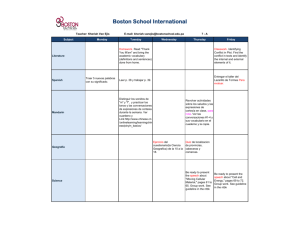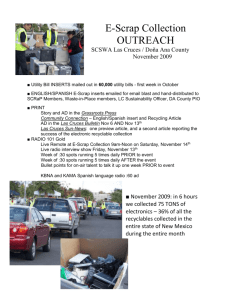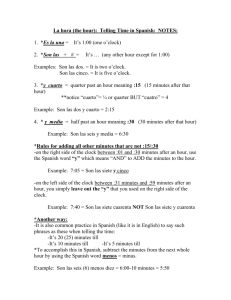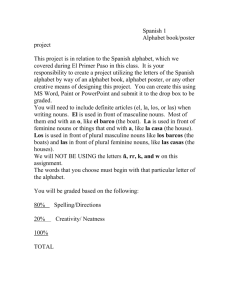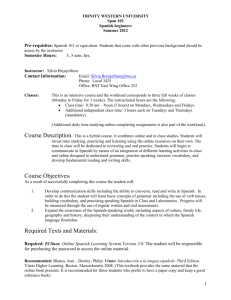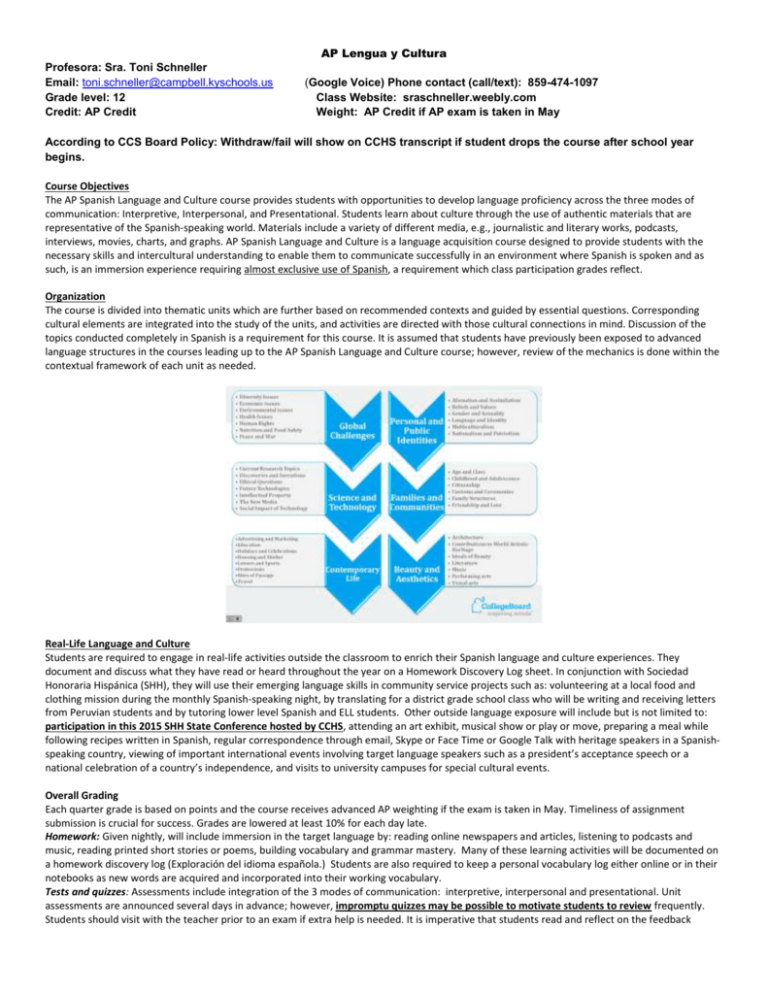
AP Lengua y Cultura
Profesora: Sra. Toni Schneller
Email: toni.schneller@campbell.kyschools.us
Grade level: 12
Credit: AP Credit
(Google Voice) Phone contact (call/text): 859-474-1097
Class Website: sraschneller.weebly.com
Weight: AP Credit if AP exam is taken in May
According to CCS Board Policy: Withdraw/fail will show on CCHS transcript if student drops the course after school year
begins.
Course Objectives
The AP Spanish Language and Culture course provides students with opportunities to develop language proficiency across the three modes of
communication: Interpretive, Interpersonal, and Presentational. Students learn about culture through the use of authentic materials that are
representative of the Spanish-speaking world. Materials include a variety of different media, e.g., journalistic and literary works, podcasts,
interviews, movies, charts, and graphs. AP Spanish Language and Culture is a language acquisition course designed to provide students with the
necessary skills and intercultural understanding to enable them to communicate successfully in an environment where Spanish is spoken and as
such, is an immersion experience requiring almost exclusive use of Spanish, a requirement which class participation grades reflect.
Organization
The course is divided into thematic units which are further based on recommended contexts and guided by essential questions. Corresponding
cultural elements are integrated into the study of the units, and activities are directed with those cultural connections in mind. Discussion of the
topics conducted completely in Spanish is a requirement for this course. It is assumed that students have previously been exposed to advanced
language structures in the courses leading up to the AP Spanish Language and Culture course; however, review of the mechanics is done within the
contextual framework of each unit as needed.
Real-Life Language and Culture
Students are required to engage in real-life activities outside the classroom to enrich their Spanish language and culture experiences. They
document and discuss what they have read or heard throughout the year on a Homework Discovery Log sheet. In conjunction with Sociedad
Honoraria Hispánica (SHH), they will use their emerging language skills in community service projects such as: volunteering at a local food and
clothing mission during the monthly Spanish-speaking night, by translating for a district grade school class who will be writing and receiving letters
from Peruvian students and by tutoring lower level Spanish and ELL students. Other outside language exposure will include but is not limited to:
participation in this 2015 SHH State Conference hosted by CCHS, attending an art exhibit, musical show or play or move, preparing a meal while
following recipes written in Spanish, regular correspondence through email, Skype or Face Time or Google Talk with heritage speakers in a Spanishspeaking country, viewing of important international events involving target language speakers such as a president’s acceptance speech or a
national celebration of a country’s independence, and visits to university campuses for special cultural events.
Overall Grading
Each quarter grade is based on points and the course receives advanced AP weighting if the exam is taken in May. Timeliness of assignment
submission is crucial for success. Grades are lowered at least 10% for each day late.
Homework: Given nightly, will include immersion in the target language by: reading online newspapers and articles, listening to podcasts and
music, reading printed short stories or poems, building vocabulary and grammar mastery. Many of these learning activities will be documented on
a homework discovery log (Exploración del idioma española.) Students are also required to keep a personal vocabulary log either online or in their
notebooks as new words are acquired and incorporated into their working vocabulary.
Tests and quizzes: Assessments include integration of the 3 modes of communication: interpretive, interpersonal and presentational. Unit
assessments are announced several days in advance; however, impromptu quizzes may be possible to motivate students to review frequently.
Students should visit with the teacher prior to an exam if extra help is needed. It is imperative that students read and reflect on the feedback
provided, as it is there to help improve language proficiency and avoid the same errors on future assignments. Some assignments may be required
to be rewritten or redone until higher level proficiency is demonstrated.
NOTE: The mid-term and final exam are in AP format: Because of their overall usefulness in assessing student readiness, there will be no
exemption granted.
Notebook: Students are responsible for maintaining a 3-ring binder to organize homework exploration log sheets, notes, feedback from graded
assignments, practice exam components, personal and assigned vocabulary logs, rubrics, and writing and grammar handouts. Notebooks will be
considered in a student’s overall course grade.
Verbal Assessments: Will be used to promote fluency and will be both individual and in small groups. These will usually be some type of
presentational speaking or interpersonal speaking such as a simulated conversation or a “role play” scenario between two students or a
presentational speaking assignment. Each student will also research and present cultural comparisons between the student’s own country and a
Spanish speaking country/community.
Class Participation: Based on exclusive use of Spanish and ease of use. Speaking the language increases fluidity and accuracy. Risk-taking is
rewarded. The goal is communication, not perfection. Use of English inhibits learning, weakens the process and will result in a lower course grade.
We will be using www.classdojo.com to track in-class communication. Points earned can be monitored by both parent and student. Weekly points
will be added to the overall point scores.
Activities to address Learning Objectives will include but are not limited to:
•Daily, Students explore a word a day (palabra del día), analyze its meaning, root, synonyms and antonyms and make linguistics comparisons.
•Daily, Homework Discovery Logs and
• Weekly, students will submit via Showbie, email, Lingtlanguage.com, Audio Dropbox, Video Dropbox, or Google Voice phoned in podcasts
an assigned simulated conversation or a cultural comparison speaking presentation. All samples are assessed using the AP scoring
guidelines. Sometimes the teacher will the work and other times the students and their classmates score each other’s. This is an excellent
way for students to internalize and understand the scoring guidelines and master the interpersonal and presentational speaking parts of the
exam. Assignments will be evaluated based on: organization, cultural relevancy, range and appropriateness of vocabulary, and grammatical
accuracy.
• Weekly, students may share presentations based on new information found during Homework Exploration time with cultural and linguistic
dialog following to promote interpersonal communication; as well as, to develop needed vocabulary and confidence in debate
• During each unit, a formal, well-organized persuasive essay covering the overall theme of focus will be submitted. The essay is evaluated for its
content, organization, cultural relevancy, range and appropriateness of vocabulary, and grammatical accuracy.
• Other frequent writing will include: journal entries and blogs, letters, e-mails, poems, dialogs and written reactions to articles, lectures,
discussions, podcasts, etc...
• Once every quarter, the class hosts a night where students watch a movie from a Spanish-speaking country. Cultural and historical relevance will
be considered when selecting these films. As an alternative to Noche de Película, the class may host a Noche de Cultura where students can
showcase their projects or listen to a guest speaker.
Course Planner (A full pacing guide is available upon request)
Through the study of the following AP topics, students build the necessary skills to reach the assessment objectives through the expansion of their
receptive, productive, and interactive skills.
AP themes to be covered include:
•
La belleza y la estética
•
La vida contemporánea
•
Las familias y las comunidades
•
Los desafíos mundiales
•
Las identidades personales y públicas
•
La ciencia y la tecnología
Basic Unit Design
This course organization is based on Vista Higher Learning textbook: TEMAS which is totally built on authentic resources that not only provide the
major content of the thematic units and contexts, but which also present students with a plethora of cultural content through which to explore
products, practices, and perspectives of the Spanish-speaking world. TEMAS is the primary resource or anchor for the course, very aligned and
written in concert with the guidelines and explanations in the Curriculum Framework; however, REA’s workbook: AP Spanish Language and
Culture All Access will also be used frequently in order to practice the specific testing mechanism of the AP Exam. All units begin with Preguntas
esenciales and are also structured to include six contextual lessons, each reflecting a recommended context of the Curriculum Framework. By
both starting and ending with the essential questions, backward design is easily accomplished, thinking first of what it is that I want the students
to know and be able to communicate about, as we explore authentic materials within Spanish-speaking cultures of the world in which we live.
The following are a themes, essential questions and sample activities used throughout the course and may be modified based on students’
interests and current events. They do not describe a linear progression of all activities that are done under each theme. (A full pacing guide is
available upon request)
Tema 1: Las familias y las comunidades
Recommended Contexts: Las comunidades educativas, Las redes sociales, La geografía humana, Las tradiciones y los valores, La ciudadanía global, y
La estructura de la familia
Essential Questions/Preguntas Esenciales:
1. ¿Cómo se define la familia en distintas sociedades?
2. ¿Cómo contribuyen los individuos al bienestar de las comunidades?
3. ¿Cuáles son las diferencias en los papeles que asumen las comunidades y las familias en las diversas sociedades del mundo?
Sample Learning Activities/Resources
Interpretive Communication, Interpersonal Communication
Activity #1
• In an online discussion forum, students respond/comment on the essential
questions. Students also comment on two of their classmates’ responses.
Tema 2: La ciencia y la tecnología
Recommended Contexts: Tecnología, Individuo y sociedad, El cuidado de la salud y la medicina, La ciencia, y la ética, Los fenómenos naturales, El
aceso a la tecnología, y Las innovaciones tecnológicas
Essential Questions/Preguntas Esenciales
1. ¿Qué impacto tiene el desarrollo científico y tecnológico en nuestras vidas?
2. ¿Qué factores han impulsado el desarrolla y la innovación en la ciencia y la tecnología?
3. ¿Qué papel cumple la ética en los avances científicos?
Sample Learning Activities/Resources
Thematic Vocabulary:
1. In groups of three, students write thematic vocabulary associated with science and
technology. Words that are unfamiliar are defined by other students in Spanish.
2. The teacher selects one group to write the identified vocabulary on the white board.
Each remaining group follows, only adding those not already listed. The teacher may
also add additional vocabulary with which students may not already be familiar.
3. After a discussion, the class decides on a final list.
Tema 3: La belleza y la estética
Recommended Contexts: Definiciones de la belleza, La moda y el diseño, El lenguaje y la literatura, Las artes visuales y escénicas, La arquitectura,
Definiciones de la creatividad
Essential Questions/Preguntas Essenciales
1. ¿Cómo se establecen las precepciones de la belleza y la creatividad?
2. ¿Cómo influyen los ideales de la belleza y la estética en la vida cotidiana?
3 ¿Cómo los artes desafían y reflejan las perspectivas culturales?
Tema 4: La Vida Contemporánea
Recommended Contexts: La educación y las carreras profesionales, El entretenimiento y la diversión, Los viajes y el ocio, Las relaciones personales,
Los estilos de vida, Las tradiciones y los valores sociales.
Essential Questions/Preguntas Essenciales
1. ¿Cómo definen los individuos y las sociedades su propia calidad de vida?
2. ¿Cómo influyen los productos culturales, las prácticas y las perspectivas de la gente en la vida contemporánea?
3. ¿Cuáles son los desafíos de la vida contemporánea?
Tema 5: Los Desafíos Mundiales
Recommended Contexts: Los temas económicos, Los temas del medioambiente, La población y la demografía, El bienestar social, El pensamiento
filosófico y la religión, y La conciencia social.
Essential Questions/Pregunatas Essenciales
1. ¿Cuáles son los desafíos sociales, políticos y el medioambiente que enfrentan las sociedades del mundo?
2. ¿Cuáles son los orígenes de esos desafíos?
3. ¿Cuáles son algunas posibles soluciones a esos desafíos?
Tema 6: Las Identidades Personales y Públicoas
Recommended Contexts: La enajenación y la asimilación, La autoestima, La identidad nacional y la identidad étnica, Los intereses personales, Las
creencias personales, y Los héroes y los personajes históiricos.
Essential Questions/Pregutas Esenciales
1. ¿Cómo se expresan los distintos aspectos de la identidad en diversas situaciones?
2. ¿Cómo influyen la lengua y la cultura en la identidad de una persona?
3. ¿Cómo se desarrolla la identidad de una persona a lo largo del tiempo?
We will use a shared class Symbaloo: http://www.symbaloo.com/mix/aplenguaycultura1 to quickly and easily access many of the online
websites and resources deemed useful to promote high level language learning or cultural awareness. Students are encouraged to create a
personal learning environment through Symbaloo and add the shared class webmix. It should be noted that this is an evolving environment and
may change as new resources are discovered. Below is a visual of the current links:
Additional Printed Texts Include:
•Draggett, Parthena, Temas AP Spanish Language and Culture, Vista Higher Learning, 2014.
•Frisancho, Jorge, AP Spanish Language and Culture Exam Preparation, Vista Higher Learning, 2014
• Alexandru Ed.D, Adina, Cerón de Calvo, Marta, Garcia, Veronica A, Sevilla, Berto, Rodriguez, Karolyn, AP Spanish Language and Culture: All
Access, REA, 2014
• Díaz, José, M. AP Spanish Preparing for the Language and Culture Examination, Fourth Edition Pearson Prentice Hall, 2014
•Blanco-Tocaimaza-Hatch, Imagina: 2nd Edition, Vista Higher Learning, 2011
•Collins, Stephen J, Díaz, José M, Nadel, Maria F, Abriendo Paso Temas y Lecturas, Pearson, 2013
•Gatski, Barbara, McMullan, John, Tríangulo Aprobado 5th Edition, Wayside Publishingm 2013
•Zaya-Bazán, Eduardo, Conexiones: Comunicación y Cultura, Prentice Hall, 2010
•Kanter, Abby, Ecuentros Maravillosos: Gramática a través de la literature, Pearson/Prentice Hall, 2011
Links found on the current class symbaloo include:
Ver-taal
www.ver-taal.com/
University of Texis at Austin www.laits.utexas.edu/spe/
Centro Virtual Cervantes
http://cvc.cervantes.es/ensenanza/actividades_ave/aveteca.htm
20 minutos
www.20minutos.es/
Centro de Noticias ONU
www.un.org/spanish/News/
La Crónica de Hoy
www.cronica.com.mx/
El Mercurio
www.emol.com/
El Mundo
www.elmundo.com/
El País
www.elpais.com/
Reforma
www.reforma.com/
La Tercera
www.latercera.com/
Audio, Visual and Audiovisual Resources: [CR2a]
BBC Mundo
www.bbcmundo.com/
CNN en español
http://cnnespanol.cnn.com/
Nuevos Horizontes
www.nuevoshorizontes.org/
Radio d las Naciones Unidas www.unmultimedia.org/radio/spanish/
Radio Nederland
www.rnw.nl/espanol
Audio Lingua
http://www.audio-lingua.eu/?lang=en
Notes In Spanish
http://notesinspanish.com
Music:
Current hits found aired on Spanish speaking radio stations or featured on Zachary Jones Zambombazo website.

